|
||||
Keeping On Track: Spotlight on SenegalVisit to DMP Senegal Project sites 17-21 May 2005The DMP continuously monitors its progress in order to meet its milestones. Monitoring visits are an occasion to highlight emerging achievements as well as to identify needed adjustments. Dr. Ramadjita Tabo, DMP Regional Coordinator for West and Central Africa, surveyed Senegal's DMP work during 17 to 21 May 2005, in conjunction with National Coordinator Dr Tamba Abdourhamane. Thies region (17 June 2005)
Kaolack region (19 June 2005)The focal point of DMP in Kaolack is ANCAR (Agence Nationale de Conseil Agricole). Regional Director Mr. Mamadou Dione and the officer in charge of field activities, Mrs. Khady Sow Ndiaye led the visit. Major activities of ANCAR include the genetic improvement of forages for livestock feed and milk production; home gardens (Moringa and pigeon pea); and seed production.
Women collect and sell fruits of Ziziphus mauritania, tamarind, baobab, and other useful trees/plants. Although the harvest is done collectively, it was noted that the revenues from the sales are managed individually. This appears to limit community benefits and should be looked into further. The DMP can assist in the elaboration of rules and regulations for the collective management of the reserve to ensure a balance between sustainability and individual livelihood enhancement. Next, the monitoring team travelled to ISRA's (Institut Sénégalais de Recherche Agronomiques) Nioro station where well-kept tree seedling nurseries provide capacity for scaling-up promising DMP tree-crop based systems.
In the next village of Ngothie, a forest reserve of about 40 ha established by local communities with the help of a German project to restore biodiversity ('mis-en defens' approach) was visited. Mr Wamigne Diouf, President of the local farmers association and Mr. Abdoulaye Djaye, responsible for monitoring and evaluation are satisfied that the reserve is being managed well. Plant and tree species are recovering, and fauna (animals) are rebounding. A fuelwood shortage in the communities is being addressed through planned cutting of some trees from the reserve. Estuary zone (21 June 2005)
DMP complements IUCN by reinforcing capacities of local rural organizations through a participatory approach. Degraded and alkaline soils are being rehabilitated. Women's income-generating activities such as processing fish for sale and the use of improved stoves are being assisted. Ecotourism is also being strengthened. In the village of Djilass a nursery that is managed by 2 farmers associations was visited with the guidance of Ms Mariama Ndour. One was composed of 24 women and another, of 24 men. Various tree seedlings (mangoes, Ziziphus mauritania, etc.) are being produced. ConclusionsDMP partnerships in Senegal are strong. The monitoring visit was a good opportunity to learn and exchange ideas between DMP teams and partners. A solid foundation is in place for the scaling-up of best-bet technologies identified in the previous DMP phase I, namely the Pomme du Sahel, African Market Garden, ‘mis-en defens’ forest biodiversity reserve approach, and soil-water-nutrient management options.
Return to On the Edge table of contents |
||||
|

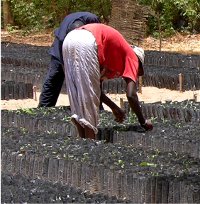 The
first stop was in the station of the Ministry of Forestry and Water
Resources in Bandia, about 70 km south of Dakar, where seedlings of
Acacia melifera are being produced (left) to be used as live
fences. African Market Gardens (AMGs) will also be established, to
train farmers and generate income, notably in collaboration with the
women’s association, which expressed strong interest.
The
first stop was in the station of the Ministry of Forestry and Water
Resources in Bandia, about 70 km south of Dakar, where seedlings of
Acacia melifera are being produced (left) to be used as live
fences. African Market Gardens (AMGs) will also be established, to
train farmers and generate income, notably in collaboration with the
women’s association, which expressed strong interest. 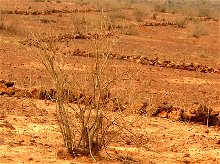 Next
came a stop near the village of Pelew where highly degraded lands
are being rehabilitated (see photo at right). The site was fenced by
farmer groups, stone bunds were constructed and various
Acacia species were planted along the gullies. The Sahelian
Eco-Farm (SEF) will be established and Ziziphus mauritania (Pomme
du Sahel) will be planted. A farmer has already established a pilot
nursery to raise Pomme du Sahel seedlings. More farmers will be
trained.
Next
came a stop near the village of Pelew where highly degraded lands
are being rehabilitated (see photo at right). The site was fenced by
farmer groups, stone bunds were constructed and various
Acacia species were planted along the gullies. The Sahelian
Eco-Farm (SEF) will be established and Ziziphus mauritania (Pomme
du Sahel) will be planted. A farmer has already established a pilot
nursery to raise Pomme du Sahel seedlings. More farmers will be
trained.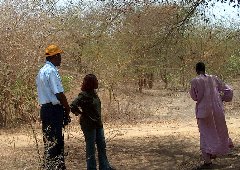 The
first stop was in the village of Sambandé. Approximatively 1100
hectares of biodiverse land are under protection. This reserve is
the property of about 10 villages in that area. They collectively
manage the natural resources of this reserve. Mr Mamadou Ndiaye, one
of the villagers ensures that no trees, plants, fruits or other
products from this protected area are used in ways that violate
community rules and regulations. As a result, endangered plant and
animal species have recovered.
The
first stop was in the village of Sambandé. Approximatively 1100
hectares of biodiverse land are under protection. This reserve is
the property of about 10 villages in that area. They collectively
manage the natural resources of this reserve. Mr Mamadou Ndiaye, one
of the villagers ensures that no trees, plants, fruits or other
products from this protected area are used in ways that violate
community rules and regulations. As a result, endangered plant and
animal species have recovered.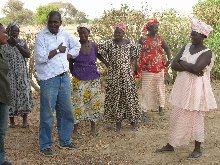 Guided
by Mr. Oumar Toure, the tour then proceeded to the village of Ngane
Ndiogou in the Dya arrondissement. There the DMP works with a women’
association (about 35 members, founded in 1980) whose economic
activities include horticulture, cultivation of groundnut, cowpea,
roselle (bissap), millet grinding using improved grinding equipment,
the use of improved cooking equipment, and seedling nurseries for
live fences. To reduce labor and water inefficiency on their small
(0.1 ha) but well-tended horticultural plots, the DMP is helping
them install drip irrigation following the AMG model.
Guided
by Mr. Oumar Toure, the tour then proceeded to the village of Ngane
Ndiogou in the Dya arrondissement. There the DMP works with a women’
association (about 35 members, founded in 1980) whose economic
activities include horticulture, cultivation of groundnut, cowpea,
roselle (bissap), millet grinding using improved grinding equipment,
the use of improved cooking equipment, and seedling nurseries for
live fences. To reduce labor and water inefficiency on their small
(0.1 ha) but well-tended horticultural plots, the DMP is helping
them install drip irrigation following the AMG model. 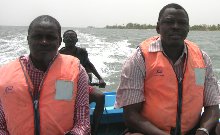 Mr.
Ngor Ndour of IUCN (The World Conservation Union) led a
motorized-canoe visit to the mangrove area on Senegal's coast near
the village of Marfafaco in the Fatick region, Foundioudje
Department, Delta of Saloun. Mangrove is an excellent source of fuel
wood; however due to habitat degradation and harvesting, the
mangrove area is declining at an alarming rate. Some activities
include the replanting and care of mangrove areas as plantations for
fuel wood and sequestration of carbon, facilitating access of rural
communities to micro-credit through international carbon credit
mechanisms.
Mr.
Ngor Ndour of IUCN (The World Conservation Union) led a
motorized-canoe visit to the mangrove area on Senegal's coast near
the village of Marfafaco in the Fatick region, Foundioudje
Department, Delta of Saloun. Mangrove is an excellent source of fuel
wood; however due to habitat degradation and harvesting, the
mangrove area is declining at an alarming rate. Some activities
include the replanting and care of mangrove areas as plantations for
fuel wood and sequestration of carbon, facilitating access of rural
communities to micro-credit through international carbon credit
mechanisms.